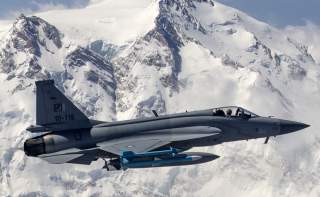Pakistan's Next War With India Will Involve Russia and China (Even If They Don't Join In)
It's all about the Chinese-Pakistani JF-17 fighter.
Key point: Chinese design, Russian engine, Pakistani flown.
The 2019 India-Pakistan border skirmish resulted in major shake-ups within the Indian Air Force (IAF). The most accepted narrative, that of a loss of an IAF MiG-21 Bison to no losses of the Pakistan Air Force bodes poorly for the IAF. But interestingly, according to a July interview, the skirmish marked one of the first “hot” use of Pakistan’s new Chinese JF-17 “Thunder” fighters.
The JF-17 is a relatively new single-engine fighter, meant to compete against other light fighters like the F-16, Gripen, and MiG-29 for export contracts. As the Pakistan Air Force (PAF) is the only large user, most solid information about the aircraft is from Chinese marketing documents. But the July interview gives one pilot’s opinion on how the JF-17 stacks up against most common adversaries, from Sukhois to F-16s.
The extent of the JF-17’s “hot” usage following the border skirmish was in patrols near the border. In some incidents, the pilot said that during these patrols, he was getting radar lock-on Su-30MKIs at ranges in excess of 100 kilometers.
However, this doesn’t mean that a JF-17 could kill with a missile at that range. The JF-17’s primary beyond-visual-range (BVR) armament is the PL-12 missile, which is still undergoing integration (as of February 2019). During the actual border air skirmish, PAF F-16s lobbed AIM-120C-5 AMRAAM missiles at similar ranges, which forced IAF aircraft to go defensive to dodge the missiles, but no kills were scored. As the PL-12 is said to have a similar range to the AMRAAM, it’s likely that its kinematic performance at range is similar, and it too wouldn’t be able to score a kill.
But if the JF-17 allows the pilot to “lob” a missile at planes at such ranges, it still might be a step ahead of the IAF’s Su-30MKIs. According to an NDTV report, the Russian R-77 missiles cannot engage targets past 80 km.
Despite the Su-30’s missile limitations, the JF-17 pilot said that the Su-30 was one of the most formidable threats the PAF faces. This is likely due to the strong engines and maneuvering capability of the Su-30, which allows it to recover energy quickly after maneuvering and makes it hard to shoot down in a within visual range (WVR) engagement.
Interestingly, the pilot then goes onto state that he’s not that afraid of the Su-30 because he’s trained against F-16s with AMRAAMs, which he thinks is a far superior missile. The pilot also states that the MICA on the Mirage is also a significant threat.
This suggests that the pilot probably thinks that the fight will be largely decided, or largely influenced by the BVR stage of the engagement and that the JF-17’s capabilities in that arena are competitive to the F-16 and Mirage. However, the pilot does say that the JF-17’s limited BVR loadout is its main weakness, as most models of the JF-17 can only carry four BVR missiles, compared to the Su-30MKI which can carry eight or more.
The pilot also gives good marks to the JF-17 for reliability, flight characteristics, and maintenance. As the JF-17 is one of China’s “clean slate” designs, this bodes well for the reliability characteristics of the current generation of Chinese aircraft. However, the JF-17 still uses a Russian engine, and the PAF rejected offers to use Chinese engines in their JF-17s in 2015. Engines remain a critical weakness in the Chinese aerospace industry.
Charlie Gao studied political and computer science at Grinnell College and is a frequent commentator on defense and national-security issues.
Image: Wikipedia.
(This article originally appeared earlier this year and is being republished due to reader interest.)

